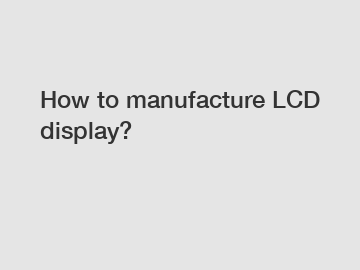How to manufacture LCD display?
In today's digital age, LCD displays are ubiquitous - be it our smartphones, televisions, or even commercial advertising billboards. With their vibrant colors, sharp resolutions, and slim form factors, we are fascinated by the seamless visual experiences these displays provide. But have you ever wondered how these marvels of technology are manufactured? Join us as we delve into the fascinating world of LCD display production, exploring the intricate processes and cutting-edge technologies involved.
Section 1: Understanding the Basics of LCD Displays.
LCD stands for Liquid Crystal Display, a technology that utilizes liquid crystals to manipulate light and create images. To manufacture an LCD display, several critical components and processes come together. The main components of an LCD display include a backlight, color filters, a liquid crystal layer, and a thin-film transistor (TFT) array.

Section 2: Expertise and Experience - The Key Ingredients.
Manufacturing LCD displays requires an exceptional level of expertise and experience. The crucial first step is to design the panel's specifications, such as screen size, resolution, and color gamut. Designers with an in-depth understanding of optics and display technology work meticulously to ensure optimal performance and visual quality.
Section 3: Semi-conductor Fabrication Techniques.
One of the fundamental processes in LCD display manufacturing is semiconductor fabrication. This process involves depositing layers of materials onto glass substrates precisely. Techniques like physical vapor deposition (PVD), chemical vapor deposition (CVD), and sputtering are used to create thin films with extraordinary precision. These films serve as electrical conductors, passivators, and insulators.
Section 4: Liquid Crystal Alignment and Color Filters.
For an LCD display to produce distinct colors, a precise arrangement of liquid crystals and color filters is required. A coating technique called photolithography is utilized to create the microscopic patterns needed for aligning liquid crystals and forming color filters. The use of advanced and reliable optical alignment methods is crucial to ensure consistency and accuracy.
Section 5: Thin-Film Transistors (TFT) Fabrication.
Thin-Film Transistors play a vital role in controlling each individual pixel of an LCD display. Transistors are fabricated on glass substrates using techniques like photolithography and etching. These transistors act as switches, regulating the electric current that controls the liquid crystals, resulting in the desired image.
Section 6: Assembly and Testing.
Once all the individual components are fabricated, they are meticulously assembled under highly controlled conditions. The backlight, color filters, liquid crystal layer, and TFT array are carefully arranged and bonded. Next, delicate bonding techniques like anisotropic conductive films and optical adhesives are employed to establish connections between components.
Section 7: Quality Assurance and Testing.
To ensure the reliability and performance of each unit, rigorous quality control measures are enacted throughout the manufacturing process. LCD displays undergo extensive testing for factors like uniformity, viewing angles, color accuracy, and response time. These tests ensure that only displays meeting the highest standards are shipped to customers.
Conclusion:
Manufacturing LCD displays is an intricate and highly specialized process, demanding a unique blend of expertise, technology, and precision. From the initial design phase to assembly, every step requires careful attention to detail to achieve the levels of excellence we expect from LCD displays. As technology continues to advance, the future of LCD manufacturing holds even greater potential for innovative displays that captivate our senses and drive the digital revolution forward.
The company is the world’s best Dianguang, Dianguang Electronics, Dianguang Electronics supplier. We are your one-stop shop for all needs. Our staff are highly-specialized and will help you find the product you need.
154
0
0


Comments
All Comments (0)